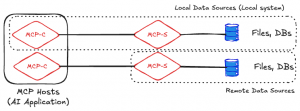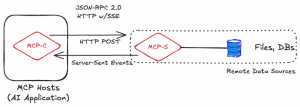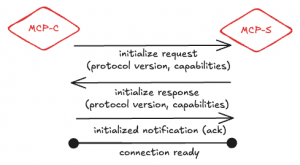MCP for DevOps – Collection Opener and MCP Structure Intro
You will have undoubtedly heard about Anthropic’s MCP (Mannequin Context Protocol) open supply challenge. In the event you haven’t, I hope your trip on a distant island with out web entry was pretty!
As a die-hard YouTube Premium fan, I’m inundated with video suggestions with themes like “What’s MCP?” “OMG, This Modifications Every thing,” and my favourite, “Goodbye Builders, MCP is Right here to Keep.” Severely? Whereas it’s a incredible challenge, it isn’t right here to switch us.
Over the subsequent a number of weeks, I’ll delve into these subjects:
MCP—Why Ought to You Care?: This can present a short overview of MCP from a communication, discovery, and interplay perspective. We’ll then discover what it appears to be like like on the wire and the way it capabilities as a shopper/server structure, adopted by numerous use circumstances. I received’t cowl the historical past of MCP or different important data, as numerous glorious sources can be found on YouTube, dev.to, Medium, and elsewhere.
MCP for DevOps: I’ll talk about a choice of use circumstances that work nicely for DevOps, NetOps, and SecOps roles.
MCP How-to: That is the place issues get thrilling. I’ll current a number of demos and walk-throughs for the next use circumstances:
- Cursor with GitHub: Use Cursor as an MCP shopper to programmatically work together with an MCP server that integrates with GitHub for a Cisco DevOps workflow
- Cursor with Argo CD: Use Cursor as an MCP shopper to programmatically work together with an MCP server that employs Argo CD for a Cisco DevOps workflow
- Claude Desktop & DevOps Workflows: We’ll swap issues up through the use of Claude Desktop as a substitute of Cursor to show flexibility on the MCP shopper facet
On the finish of the sequence, I’ll tie all of this collectively to point out how Cursor, with a number of MCP shoppers, can drive adjustments to Ansible playbooks in a GitHub repository, triggering actions within the Argo CD workflow. Finally, we’ll use the Ansible playbook to change configuration settings on Cisco options comparable to Cisco ISE (Id Providers Engine) and different Cisco merchandise.
I hope you be part of me on this journey.
Let’s get began with discussing the MCP structure and why you must care about it.
MCP Intro—Why Ought to You Care?
Welcome to the primary submit in our three-part technical sequence on Mannequin Context Protocol (MCP), a brand new, centered protocol constructed to assist AI purposes and brokers work together with instruments, APIs, recordsdata, and databases persistently and programmatically.
In the event you’re in DevOps and experimenting with AI-driven automation, MCP deserves your consideration—not as a silver bullet however as a sensible step towards cleaner integration between AI methods and your operational stack. That mentioned, it’s early days. MCP is new and shifting quick, and whereas it already solves a lot of real-world issues, there are nonetheless corners to shine and edge circumstances it doesn’t but cowl.
What’s MCP, and Why Does It Matter?
As illustrated in Determine 1, Mannequin Context Protocol (MCP) is a protocol that gives a uniform approach to plug in an AI mannequin into instruments and companies.
Determine 1. MCP with LLMs and Instruments
It’s:
- A light-weight communication protocol designed particularly for AI brokers and purposes.
- Constructed to attach these brokers to instruments, APIs, databases, and file methods.
- Structured as a shopper/server structure—easy and predictable.
- Plumbing
It isn’t:
- A messaging protocol for agent-to-agent communication.
- An LLM, database, AI assistant or agent.
- A general-purpose integration platform.
- A substitute on your present APIs or knowledge bus.
MCP’s job is tightly scoped: give an AI agent a clear, standardized approach to uncover, request, and invoke capabilities on present tool-based infrastructure. In case your LLM-powered bot must name a REST API, checklist recordsdata, or question a database—MCP gives the glue.
MCP issues as a result of it reduces and, in lots of circumstances, removes the toil for AI purposes and brokers to seek out, hook up with, and leverage exterior instruments and companies comparable to APIs, knowledge sources, and different non-AI native instrument units. For Dev/Web/SecOps employees, it may carry quick worth so that you can leverage an AI agent to hook up with your present knowledge sources and APIs in order that an operationally-focused agent can extra precisely full duties.
We’ll talk about use circumstances within the subsequent weblog, however think about you should create a workflow that works with Ansible Playbooks, NetBox, and GitHub and automate configurations towards your infrastructure.
An instance workflow could seem like this:
- You manually create a Jinja2 template for Ansible and host it on GitHub.
- Collect knowledge out of your NetBox deployment.
- You employ Python + Jinja2 to populate the playbook template with knowledge from NetBox after which invoke Ansible through a Python module, CLI, runner, and many others.
- Ideally, you employ a CI/CD instrument to auto-run this workflow.
Quick ahead from the great ’ole days; you or somebody in your group study concerning the energy of AI Brokers and create a sequence of AI brokers that may faucet into every instrument and knowledge supply with out writing any code. They’ll leverage MCP to hook up with every useful resource as MCP servers and work together with them natively—no particular script code. No scouring the web for SDKs or some mysterious script somebody recommends that you just don’t perceive. To me, that is one in every of many value-add use circumstances of MCP.
Overview of MCP – Structure and Core Elements
MCP has a streamlined structure and there aren’t many shifting elements.
As illustrated in Determine 2 MCP makes use of a shopper/server structure. Let’s outline what the shopper and server elements do.
Determine 2. MCP Elements

Determine 2 exhibits an MCP host which is an AI software comparable to an AI agent, IDE, coding assistant, and many others..
The MCP shopper (MCP-C) is software program that runs on MCP hosts and has one-to-one connections to MCP servers (MCP-S).
The MCP server is software program that represents particular service or instrument capabilities.
The MCP host makes use of the language-specific MCP SDK for shopper connections (instance: MCP Python SDK) to ascertain connections to MCP servers. The MCP SDK is used for each client-side and server-side code.
Instance Python MCP shopper code.
Instance Python MCP server code.
Many present MCP shoppers are full purposes or AI brokers with the MCP shopper SDK performance natively in-built. You may see an instance checklist right here: https://modelcontextprotocol.io/shoppers
There are quite a few sources of MCP server lists on the Web. Here’s a checklist from the MCP challenge: https://modelcontextprotocol.io/examples. Some MCP shopper suppliers, comparable to Cursor, have their very own checklist of servers: https://cursor.listing/.
Determine 2 exhibits that every MCP-C occasion has a one-to-one connection to every MCP-S occasion. Within the determine, there are two MCP shoppers operating on the MCP host, an AI agent on this instance. The primary MCP shopper is connecting to a locally-hosted MCP server that gives native machine file system entry. The second MCP shopper is connecting to a remotely hosted MCP server that’s offering entry to a distant file system.
MCP shoppers alternate messages with MCP servers utilizing JSON-RPC 2.0 (because the wire format). For native knowledge sources, MCP makes use of JSON-RPC over stdio (Normal Enter/Output) because the transport. Determine 3., illustrates how an MCP-C connects to a neighborhood MCP-S for file or DB entry utilizing stdio. The MCP-S sends JSON-RPC messages to its customary output / stdout and reads from the usual enter / stdin.
Determine 3. JSON-RPC over stdio

Right here is an instance of operating an MCP filesystem server regionally in stdio mode and proscribing entry to a really particular listing:
npx -y @modelcontextprotocol/server-filesystem /Customers/shmcfarl/code/mcp-testing Safe MCP Filesystem Server operating on stdio Allowed directories: [ '/Users/shmcfarl/code/mcp-testing' ]
Utilizing an excellent check instrument such because the MCP Inspector you’ll be able to pair a neighborhood shopper (MCP Inspector) together with your regionally operating stdio or HTTP+SSE server:
npx -y @modelcontextprotocol/inspector npx -y @modelcontextprotocol/server-filesystem /Customers/shmcfarl/code/mcp-testing
Beginning MCP inspector...
Proxy server listening on port 3000
MCP Inspector is up and operating at http://localhost:5173
Question parameters: {
transportType: 'stdio',
command: 'npx',
args: '-y @modelcontextprotocol/server-filesystem -y /Customers/shmcfarl/code/mcp-testing',
. . . [Output removed for clarity]
Spawned stdio transport
Linked MCP shopper to backing server transport
Created internet app transport
Created internet app transport
Arrange MCP proxy
Acquired message for sessionId 697bd02d-5d67-4dfc-85b9-6a12d6a99f45
Acquired message for sessionId 697bd02d-5d67-4dfc-85b9-6a12d6a99f45
Acquired message for sessionId 697bd02d-5d67-4dfc-85b9-6a12d6a99f45
Acquired message for sessionId 697bd02d-5d67-4dfc-85b9-6a12d6a99f45
MCP helps HTTP+SSE (Server-Despatched Occasions) to ship structured requests from service backends utilizing MCP servers to MCP shoppers for native or distant connections. The 2025-03-26 specification adjustments states that MCP is shifting to a extra versatile Streamable HTTP transport. Nevertheless, HTTP+SSE transport can nonetheless be used for backward compatibility. This retains it clear, traceable, and tool-agnostic. Be aware: As of the time of scripting this weblog, the brand new Streaming HTTP assist isn’t accomplished in every SDK.
Determine 4 illustrates the connection circulation for HTTP+SSE situations. Within the determine, HTTP POST is used for MCP-C -to- MCP-S messages. HTTP+SSE is used for MCP-S -to- MCP-C messages.
Determine 4. MCP-C -to- MCP-S communication utilizing HTTP+SSE

You may undergo the MCP quickstart server and shopper guides to learn to setup your individual climate shopper/server combo: https://modelcontextprotocol.io/quickstart/server. Utilizing an identical setup, you’ll be able to see some HTTP messages for stuff like a instruments checklist name:
POST /messages/?session_id=6ccde3779adf43cc9d3f5f661508310b HTTP/1.1
Host: 0.0.0.0:8080
Settle for: */*
Settle for-Encoding: gzip, deflate
Connection: keep-alive
Person-Agent: python-httpx/0.28.1
Content material-Size: 46
Content material-Kind: software/json
{"methodology":"instruments/checklist","jsonrpc":"2.0","id":2}
HTTP/1.1 202 Accepted
date: Tue, 08 Apr 2025 20:14:51 GMT
server: uvicorn
content-length: 8
Accepted
And a instrument name to get the climate forecast:
POST /messages/?session_id=6ccde3779adf43cc9d3f5f661508310b HTTP/1.1
Host: 0.0.0.0:8080
Settle for: */*
Settle for-Encoding: gzip, deflate
Connection: keep-alive
Person-Agent: python-httpx/0.28.1
Content material-Size: 134
Content material-Kind: software/json
{"methodology":"instruments/name","params":{"identify":"get_forecast","arguments":{"latitude":39.7392,"longitude":-104.9903}},"jsonrpc":"2.0","id":3}
HTTP/1.1 202 Accepted
date: Tue, 08 Apr 2025 20:14:54 GMT
server: uvicorn
content-length: 8
Accepted
And a response for the climate forecast immediate I entered for Denver, CO:
occasion: message
knowledge: {"jsonrpc":"2.0","id":3,"end result":{"content material":[{"type":"text","text":"nThis Afternoon:nTemperature: 74..FnWind: 12 mph WnForecast: Partly sunny. High near 74, with temperatures falling to around 72 in the afternoon. West wind around 12 mph, with gusts as high as 18 mph.nn---nnTonight:nTemperature: 42..FnWind: 5 to 10 mph WSWnForecast: Partly cloudy, with a low around 42. West southwest wind 5 to 10 mph, with gusts as high as 18 mph.nn---nnWednesday:nTemperature: 71..FnWind: 5 to 15 mph WnForecast: Mostly sunny, with a high near 71. West wind 5 to 15 mph, with gusts as high as 24 mph.nn---nnWednesday Night:nTemperature: 40..FnWind: 2 to 14 mph WNWnForecast: Mostly clear, with a low around 40. West northwest wind 2 to 14 mph, with gusts as high as 29 mph.nn---nnThursday:nTemperature: 68..FnWind: 2 to 8 mph ESEnForecast: Sunny, with a high near 68. East southeast wind 2 to 8 mph, with gusts as high as 16 mph.n"}],"isError":false}}
Because the specification change to Streamable HTTP could be very current and never totally applied as of the writing of this weblog, I’ll forgo doing a granular rationalization of that connection sequence. I advisable that you just learn concerning the proposed Streamable HTTP implementation right here: https://modelcontextprotocol.io/specification/2025-03-26/fundamental/transports#streamable-http.
Discovery
When an agent must work together with a instrument or service, MCP gives a useful resource discovery mechanism that lets MCP shoppers uncover obtainable sources. The MCP shopper can use direct sources or useful resource templates. You may learn extra concerning the useful resource discovery choices at https://modelcontextprotocol.io/docs/ideas/sources. However, the vital factor to know is that the objective of useful resource discovery is to seek out out the next data:
- Supported capabilities and actions
- Protocol variations
- Customized metadata
Determine 5 exhibits the MCP-C to MCP-S request/response circulation for the capabilities discovery.
Determine 5. MCP Discovery Move

Whereas there isn’t a MCP server registry that MCP shoppers can search to dynamically uncover all obtainable MCP servers and their capabilities, there are MCP server directories as was famous early within the doc. There may be an ever-growing variety of MCP directories and in lots of circumstances, all of them have the identical or related checklist of MCP servers. A couple of of the numerous websites embody:
MCP Useful resource Discovery – Instance
Let’s have a look at an instance of useful resource discovery utilizing direct sources.
I’ve the SQLite MCP Server operating on my native machine. I’m utilizing Claude Desktop as my AI software with the MCP shopper performance configured to make use of the SQLite MCP server. Here’s a snippet from my claude_desktop_config.json file:
"mcpServers": {
"sqlite": {
"command": "uvx",
"args": ["mcp-server-sqlite", "--db-path", "/Users/shmcfarl/code/mcp-testing/sqlite/test.db"]
},
Once I use Claude Desktop to instrument name SQLite and ask for an inventory of server sources, you’ll be able to see the message alternate from the MCP shopper to MCP server.
2025-04-09T18:08:37.964Z [sqlite] [info] Message from shopper: {"methodology":"sources/checklist","params":{},"jsonrpc":"2.0","id":44}
2025-04-09T18:08:37.965Z [sqlite] [info] Message from server: {"jsonrpc":"2.0","id":44,"end result":{"sources":[{"uri":"memo://insights","name":"Business Insights Memo","description":"A living document of discovered business insights","mimeType":"text/plain"}]}}
Per the MCP specification you’ll be able to see the strategy utilized by the MCP shopper is sources/checklist and the MCP server responds utilizing the direct sources format:
{
uri: string; // Distinctive identifier for the useful resource
identify: string; // Human-readable identify
description?: string; // Non-obligatory description
mimeType?: string; // Non-obligatory MIME sort
}
Conclusion
MCP is off to a powerful begin, particularly for DevOps groups experimenting with AI-driven automation.
On the identical time, it’s nonetheless a younger protocol. MCP offers you a clear basis if you happen to’re constructing AI-enabled workflows that have to work together with infrastructure and instruments safely—however you’ll nonetheless have to assess match on your particular use case.
There may be much more introductory content material that I might cowl, however I feel this lays a basis for the remainder of the weblog sequence. For the rest of the blogs it’s important so that you can know:
MCP is right for:
- Brokers want to hook up with a number of knowledge sources and companies in a regular means
- It abstracts away the per-integration code complexity – simply use the MCP SDK
- You want it for a low toil platform or with IDE integrations
What doesn’t MCP do (no less than right this moment)?
- MCP isn’t an agent-to-agent framework
- MCP isn’t used for the creation, deployment, lifecycle administration, and safety of brokers or instruments
- MCP isn’t an LLM
- MCP isn’t a knowledge supply
- MCP doesn’t dynamically uncover instruments and companies the MCP server will signify
We additionally discovered how MCP shoppers and servers work together with each other and over which varieties of protocol and messaging codecs.
Let’s cease there and decide again up within the subsequent weblog on MCP for DevOps: Use Instances
Choose to see it in motion? Watch the complete MCP for DevOps: Structure & Elements video walkthrough right here: https://youtu.be/Qdms0EHwhOw
Subsequent within the sequence
MCP for DevOps: Use Instances
✅ AI Brokers Triggering DevOps Instruments Use MCP to work together with present DevOps scripts, APIs, or companies in a regular format an AI agent can eat.
✅ Infrastructure-Conscious LLMs Let your AI apps ask structured questions like “What kubernetes companies are operating in namespace default?” or “Create a brand new database desk”—with stay solutions from methods through MCP servers.
✅ Safe Software Invocation through AI expose choose CLI instruments or automation workflows by means of an MCP server interface, permitting AI brokers to work together with them below managed circumstances comparable to utilizing a Docker scout MCP to scan pictures.
See you on the subsequent submit!
Share:

